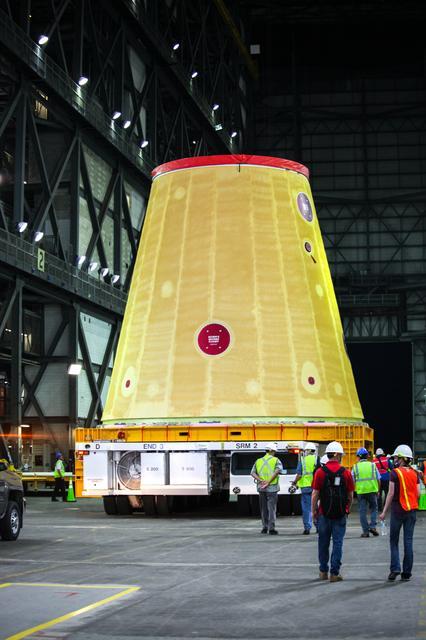Throwback Thursday: Apollo 11 FAQ Edition
Throwback Thursday: Apollo 11 FAQ Edition

With the help of the NASA History Office, we’ve identified some of the most frequently asked questions surrounding the first time humans walked on the surface of another world. Read on and click here to check out our previous Apollo FAQs.
How many moon rocks did the Apollo crews bring back? What did we learn?

The six crews that landed on the Moon brought back 842 pounds (382 kilograms) of rocks, sand and dust from the lunar surface. Each time, they were transferred to Johnson Space Center’s Lunar Receiving Laboratory, a building that also housed the astronauts during their three weeks of quarantine. Today the building now houses other science divisions, but the lunar samples are preserved in the Lunar Sample Receiving Laboratory.
Built in 1979, the laboratory is the chief repository of the Apollo samples.

From these pieces of the Moon we learned that its chemical makeup is similar to that of Earth’s, with some differences. Studying the samples has yielded clues to the origins of the solar system. In March of 2019, we announced that three cases of pristine Moon samples will be unsealed for the first time in 50 years so that we can take advantage of the improved technology that exists today!
Did you know you might not have to travel far to see a piece of the Moon up close? Visit our Find a Moon Rock page to find out where you can visit a piece of the Moon.
What did Apollo astronauts eat on their way to the Moon?

Astronaut food has come a long way since the days of Project Mercury, our first human spaceflight program that ran from 1958-1963. Back then, astronauts “enjoyed” food in cube form or squeezed out of tubes. Early astronaut food menus were designed less for flavor and more for nutritional value, but that eventually shifted as technology evolved. Astronauts today can enjoy whole foods like apples, pizza and even tacos.
Apollo crews were the first to have hot water, making it easier to rehydrate their foods and improve its taste. They were also the first to use a “spoon bowl,” a plastic container that was somewhat like eating out of a Ziploc bag with a spoon. Here’s an example of a day’s menu for a voyage to the Moon:
Breakfast: bacon squares, strawberry cubes and an orange drink.
Lunch: beef and potatoes, applesauce and a brownie.
Dinner: salmon salad, chicken and rice, sugar cookie cubes and a pineapple grapefruit drink.
What did Michael Collins do while he orbited the Moon, alone in the Command Module?

As Neil Armstrong and Buzz Aldrin worked on the lunar surface, Command Module pilot Michael Collins orbited the Moon, alone, for the next 21.5 hours. On board he ran systems checks, made surface observations and communicated with Mission Control when there wasn’t a communications blackout. Blackouts happened every time Collins went behind the Moon. In 2009, Collins wrote this in response to a flurry of media questions about the 40th anniversary of the mission:
Q. Circling the lonely Moon by yourself, the loneliest person in the universe, weren’t you lonely? A. No. Far from feeling lonely or abandoned, I feel very much a part of what is taking place on the lunar surface. I know that I would be a liar or a fool if I said that I have the best of the three Apollo 11 seats, but I can say with truth and equanimity that I am perfectly satisfied with the one I have. This venture has been structured for three men, and I consider my third to be as necessary as either of the other two.”
What will Artemis astronauts bring back when they land on the Moon?

Artemis missions to the Moon will mark humanity’s first permanent presence on another world. The first woman and the next man to explore the lunar surface will land where nobody has ever attempted to land before – on the Moon’s south pole where there are billions of tons of water ice that can be used for oxygen and fuel. We don’t know yet what astronauts will bring back from this unexplored territory, but we do know that they will return with hope and inspiration for the next generation of explorers: the Artemis generation. Make sure to follow us on Tumblr for your regular dose of space: http://nasa.tumblr.com.
More Posts from Thehkr and Others
Laying the Groundwork for a New Generation of Commercial Supersonic Aircraft
Cabin crew, prepare for takeoff. Engines roar; speed increases. You sip a cold beverage as the aircraft accelerates quietly past Mach 1 or around 600 mph. There’s no indication you’re flying over land faster than the speed of sound except when you glance at your watch upon arrival and see you’ve reached your destination in half the time. You leisurely walk off the plane with ample time to explore, finish a final report or visit a familiar face. This reality is closer than you think.

We’re on a mission to help you get to where you want to go in half the time. Using our single-pilot X-59 Quiet SuperSonic Technology (QueSST) research aircraft, we will provide rule-makers the data needed to lift current bans on faster-than-sound air travel over land and help enable a new generation of commercial supersonic aircraft.

The X-59 QueSST is unique in shape. Each element of the aircraft’s design will help reduce a loud sonic boom, typically produced by conventional supersonic aircraft, to a gentle sonic thump, making it quieter for people on the ground. To prove the quiet technology works, we will fly the X-59 over select U.S. communities to gauge the public’s response to the sound.

We are working with Lockheed Martin in Palmdale, California, to manufacture the X-59 and are making significant progress, despite the pandemic.

We finished the majority of work on the wing and closed its interior, marking the halfway point on construction of the aircraft.

The X-59 team at Lockheed Martin completed the final touches by fastening skins to the wing. A special sealant is applied so that fuel can be carried in the wings of the aircraft.

Moving at a steady pace, technicians continue to work on many parts of the aircraft simultaneously. The forebody section of the aircraft will carry the pilot and all the avionics needed to fly the aircraft.

Because of the X-59’s long nose, the pilot will rely on an eXternal Vision System (XVS), rather than a window, for forward-facing visibility. The XVS will display fused images from an advanced computing system and cameras mounted on the upper and lower part of the aircraft’s nose.

The aft part of the aircraft will hold an F414 GE engine and other critical systems. Unlike typical aircraft, the engine inlet will be located on the upper surface of the X-59 and is one of many features that will help reduce the noise heard on the ground.

Over the next several months, the team will merge all three sections together. After final assembly in 2021, the X-59 will undergo numerous tests to ensure structural integrity of the aircraft and that ¬its components work properly. First flight of the aircraft will be in 2022 and community testing will start in 2024, making way for a new market of quiet commercial supersonic aircraft.

Want to learn more about the X-59 and our mission? Visit nasa.gov/X59.
Make sure to follow us on Tumblr for your regular dose of space: http://nasa.tumblr.com.



Hadas Cohen
The Big Build: Artemis I Stacks Up
Our Space Launch System (SLS) rocket is coming together at the agency’s Kennedy Space Center in Florida this summer. Our mighty SLS rocket is set to power the Artemis I mission to send our Orion spacecraft around the Moon. But, before it heads to the Moon, NASA puts it together right here on Earth.

Read on for more on how our Moon rocket for Artemis I will come together this summer:
Get the Base

How do crews assemble a rocket and spacecraft as tall as a skyscraper? The process all starts inside the iconic Vehicle Assembly Building at Kennedy with the mobile launcher. Recognized as a Florida Space Coast landmark, the Vehicle Assembly Building, or VAB, houses special cranes, lifts, and equipment to move and connect the spaceflight hardware together. Orion and all five of the major parts of the Artemis I rocket are already at Kennedy in preparation for launch. Inside the VAB, teams carefully stack and connect the elements to the mobile launcher, which serves as a platform for assembly and, later, for fueling and launching the rocket.
Start with the boosters

Because they carry the entire weight of the rocket and spacecraft, the twin solid rocket boosters for our SLS rocket are the first elements to be stacked on the mobile launcher inside the VAB. Crews with NASA’s Exploration Ground Systems and contractor Jacobs team completed stacking the boosters in March. Each taller than the Statue of Liberty and adorned with the iconic NASA “worm” logo, the five-segment boosters flank either side of the rocket’s core stage and upper stage. At launch, each booster produces more than 3.6 million pounds of thrust in just two minutes to quickly lift the rocket and spacecraft off the pad and to space.
Bring in the core stage

In between the twin solid rocket boosters is the core stage. The stage has two huge liquid propellant tanks, computers that control the rocket’s flight, and four RS-25 engines. Weighing more than 188,000 pounds without fuel and standing 212 feet, the core stage is the largest element of the SLS rocket. To place the core stage in between the two boosters, teams will use a heavy-lift crane to raise and lower the stage into place on the mobile launcher.
On launch day, the core stage’s RS-25 engines produce more than 2 million pounds of thrust and ignite just before the boosters. Together, the boosters and engines produce 8.8 million pounds of thrust to send the SLS and Orion into orbit.
Add the Launch Vehicle Stage Adapter

Once the boosters and core stage are secured, teams add the launch vehicle stage adapter, or LVSA, to the stack. The LVSA is a cone-shaped element that connects the rocket’s core stage and Interim Cryogenic Propulsion Stage (ICPS), or upper stage. The roughly 30-foot LVSA houses and protects the RL10 engine that powers the ICPS. Once teams bolt the LVSA into place on top of the rocket, the diameter of SLS will officially change from a wide base to a more narrow point — much like a change in the shape of a pencil from eraser to point.
Lower the Interim Cryogenic Propulsion Stage into place

Next in the stacking line-up is the Interim Cryogenic Propulsion Stage or ICPS. Like the LVSA, crews will lift and bolt the ICPS into place. To help power our deep space missions and goals, our SLS rocket delivers propulsion in phases. At liftoff, the core stage and solid rocket boosters will propel Artemis I off the launch pad. Once in orbit, the ICPS and its single RL10 engine will provide nearly 25,000 pounds of thrust to send our Orion spacecraft on a precise trajectory to the Moon.
Nearly there with the Orion stage adapter

When the Orion stage adapter crowns the top of the ICPS, you’ll know we’re nearly complete with stacking SLS rocket for Artemis I. The Orion Stage Adapter is more than just a connection point. At five feet in height, the Orion stage adapter may be small, but it holds and carries several small satellites called CubeSats. After Orion separates from the SLS rocket and heads to the Moon, these shoebox-sized payloads are released into space for their own missions to conduct science and technology research vital to deep space exploration. Compared to the rest of the rocket and spacecraft, the Orion stage adapter is the smallest SLS component that’s stacked for Artemis I.
Top it off

Finally, our Orion spacecraft will be placed on top of our Moon rocket inside the VAB. The final piece will be easy to spot as teams recently added the bright red NASA “worm” logotype to the outside of the spacecraft. The Orion spacecraft is much more than just a capsule built to carry crew. It has a launch abort system, which will carry the crew to safety in case of an emergency, and a service module developed by the European Space Agency that will power and propel the spacecraft during its three-week mission. On the uncrewed Artemis I mission, Orion will check out the spacecraft’s critical systems, including navigation, communications systems, and the heat shield needed to support astronauts who will fly on Artemis II and beyond.
Ready for launch!

The path to the pad requires many steps and check lists. Before Artemis I rolls to the launch pad, teams will finalize outfitting and other important assembly work inside the VAB. Once assembled, the integrated SLS rocket and Orion will undergo several final tests and checkouts in the VAB and on the launch pad before it’s readied for launch.
The Artemis I mission is the first in a series of increasingly complex missions that will pave the way for landing the first woman and the first person of color on the Moon. The Space Launch System is the only rocket that can send NASA astronauts aboard NASA’s Orion spacecraft and supplies to the Moon in a single mission.
Make sure to follow us on Tumblr for your regular dose of space!
Every next level of your life will demand a different you.
Leonardo DiCaprio (via quotemadness)

Take time to think, it is the source of power. Take time to read, it is the foundation of wisdom.
We Just Found Water on the Moon’s Sunlit Surface

When the first Apollo astronauts returned from the Moon in 1969, the Moon’s surface was thought to be completely dry. Over the last 20 years, orbital and impactor missions confirmed water ice is present inside dark, permanently shadowed craters around the poles. But could water survive in the Moon’s sunnier regions? Using SOFIA, the world’s largest flying observatory, we found water on a sunlit lunar surface for the first time. The discovery suggests water may be distributed across the Moon’s surface, which is a whopping 14.6 million square miles. Scientists think the water could be stored inside glass beadlike structures within the soil that can be smaller than the tip of a pencil. The amount of water detected is equivalent to about a 12-ounce bottle trapped in a cubic meter volume of soil. While that amount is 100 times less than what’s found in the Sahara Desert, discovering even small amounts raises new questions about how this precious resource is created and persists on the harsh, airless lunar surface. Learn more about the discovery:
Water was found in Clavius Crater, one of the Moon’s largest craters visible from Earth.

The water may be delivered by tiny meteorite impacts…

…or formed by the interaction of energetic particles ejected from the Sun.

Follow-up observations by SOFIA will look for water in additional sunlit locations on the Moon.

We are eager to learn all we can about the presence of water in advance of sending the first woman and next man to the lunar surface in 2024 under our Artemis program. What we learn on and around the Moon will help us take the next giant leap – sending astronauts to Mars.
Make sure to follow us on Tumblr for your regular dose of space: http://nasa.tumblr.com
Throwback Thursday: Apollo 11 Moon Landing Questions Answered

The Apollo 11 Moon landing was a feat for the ages. With the help of the NASA History Office, we’ve identified some of the most frequently asked questions surrounding the first time humans walked on the surface of another world. Click here to check out our post from last week.
Is it true that the Apollo guidance computer had less computing power than a smartphone?

Believe it or not, yes! The Apollo guidance computer not only had less computing power than a smartphone, it had less computing power than the calculator you use in your algebra class. The computer, designed by MIT, had a fixed memory of 36 kilobytes and an erasable memory of 2 kilobytes. That’s fairly advanced for the time!
Why did Buzz Aldrin take a picture of his bootprint?

A substantial portion of the Apollo 11 crew’s checklist was taking photographs. Taking closeup shots of the "very fine” moon dust was a critical component of mission objectives and helped scientists better understand the surface makeup of the Moon.

Armstrong and Aldrin wore lunar overboots over their main spacesuit boots to protect them from ultraviolet radiation and hazardous rocks. To make room for the nearly 50 pounds (22 kilograms) of lunar samples, the crew left all their pairs of boots on the Moon. But don’t worry; they wouldn’t get charged an overweight baggage fee anyway.

What were the first words spoken from the surface of the Moon?

That’s somewhat subject to interpretation. Once the Lunar Module’s footpads touched the surface, Buzz Aldrin called out “Contact Light” to Mission Control. After the engine shut down, he said “ACA out of detent,” simply meaning that the Eagle’s Attitude Control Assembly, or control stick, was moved from its center position.
But the first words heard by the entire world after Apollo 11 touched down were delivered by Neil Armstrong: "Houston, Tranquility Base here. The Eagle has landed.” More than six hours later, Armstrong stepped off the Eagle’s footpad and delivered the most famous words ever spoken from the surface of another world: "That’s one small step for [a] man, one giant leap for mankind." And although we have a hard time hearing it in the recording, Armstrong clarified in a post-flight interview that he actually said, “That’s one small step for a man…”
What will the first woman and the next man to go to the Moon say when they first step on its surface?

We can’t say for sure what our next moonwalkers will decide to say, but perhaps the better question is: What would be your first words if you were to land on the Moon? There’s no doubt that the astronauts of the Artemis Generation will inspire a new crop of explorers the way Apollo Generation astronauts did 50 years ago. Make sure to follow us on Tumblr for your regular dose of space: http://nasa.tumblr.com.










武田玲奈
tumbex


-
 takeagiantstep23 liked this · 11 months ago
takeagiantstep23 liked this · 11 months ago -
 gottalottarocks liked this · 1 year ago
gottalottarocks liked this · 1 year ago -
 superpixie reblogged this · 1 year ago
superpixie reblogged this · 1 year ago -
 anisaanisa liked this · 1 year ago
anisaanisa liked this · 1 year ago -
 nandalikesstuff reblogged this · 1 year ago
nandalikesstuff reblogged this · 1 year ago -
 anisaanisa reblogged this · 1 year ago
anisaanisa reblogged this · 1 year ago -
 tonguethulhu liked this · 3 years ago
tonguethulhu liked this · 3 years ago -
 peachy-keeyn reblogged this · 3 years ago
peachy-keeyn reblogged this · 3 years ago -
 entropiccollapse liked this · 4 years ago
entropiccollapse liked this · 4 years ago -
 titania-harbinger liked this · 4 years ago
titania-harbinger liked this · 4 years ago -
 rustiancho liked this · 4 years ago
rustiancho liked this · 4 years ago -
 oshacertifiedforkliftoperator liked this · 4 years ago
oshacertifiedforkliftoperator liked this · 4 years ago -
 maj0rmin3r1 liked this · 4 years ago
maj0rmin3r1 liked this · 4 years ago -
 i-have-a-permit liked this · 4 years ago
i-have-a-permit liked this · 4 years ago -
 kenny-wind-yt reblogged this · 4 years ago
kenny-wind-yt reblogged this · 4 years ago -
 kenny-wind-yt liked this · 4 years ago
kenny-wind-yt liked this · 4 years ago -
 cplus902 reblogged this · 4 years ago
cplus902 reblogged this · 4 years ago -
 may-fires reblogged this · 4 years ago
may-fires reblogged this · 4 years ago -
 socialmediasocrates reblogged this · 4 years ago
socialmediasocrates reblogged this · 4 years ago -
 socialmediasocrates liked this · 4 years ago
socialmediasocrates liked this · 4 years ago -
 trashcat-waifu liked this · 4 years ago
trashcat-waifu liked this · 4 years ago -
 agramoon liked this · 4 years ago
agramoon liked this · 4 years ago -
 therandominternetperson liked this · 4 years ago
therandominternetperson liked this · 4 years ago -
 magicalpostdeer liked this · 5 years ago
magicalpostdeer liked this · 5 years ago -
 groovylabinabox reblogged this · 5 years ago
groovylabinabox reblogged this · 5 years ago -
 academicsinabox liked this · 5 years ago
academicsinabox liked this · 5 years ago -
 caffeinatedvampireslayer liked this · 5 years ago
caffeinatedvampireslayer liked this · 5 years ago -
 annabethisterrified liked this · 5 years ago
annabethisterrified liked this · 5 years ago -
 knaveofmogadore reblogged this · 5 years ago
knaveofmogadore reblogged this · 5 years ago -
 fendarr reblogged this · 5 years ago
fendarr reblogged this · 5 years ago -
 queerhistorymajor liked this · 5 years ago
queerhistorymajor liked this · 5 years ago -
 artimies6 reblogged this · 5 years ago
artimies6 reblogged this · 5 years ago -
 aspenalpines liked this · 5 years ago
aspenalpines liked this · 5 years ago -
 kawaiipiratetaco liked this · 5 years ago
kawaiipiratetaco liked this · 5 years ago -
 sweetpotat0s reblogged this · 5 years ago
sweetpotat0s reblogged this · 5 years ago -
 pinkiepieaddict reblogged this · 5 years ago
pinkiepieaddict reblogged this · 5 years ago -
 evolved-feral reblogged this · 5 years ago
evolved-feral reblogged this · 5 years ago -
 starystory reblogged this · 5 years ago
starystory reblogged this · 5 years ago